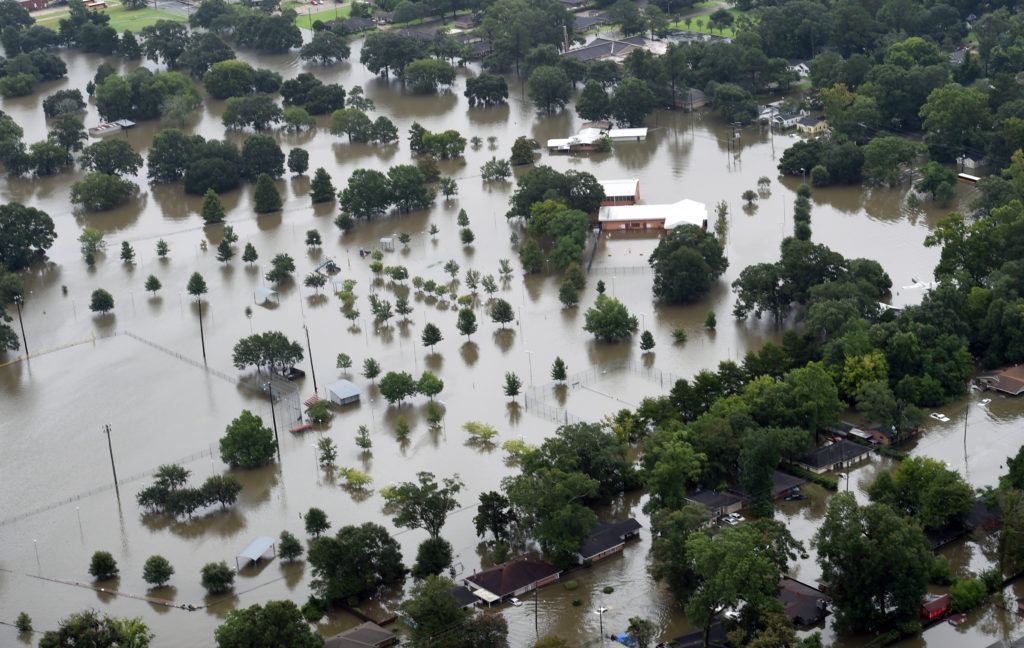Catastrophic losses this year due to extreme weather events have led to a growing interest in parametric insurance in the U.S., according to industry experts. Weather stations and satellite images are helping to make parametric coverage an increasingly affordable and viable option.
 Fort Myers, FL., September 14, 2017 – Clean up begins in Fort Myers, Florida following Hurricane Irma. Robert Kaufmann/FEMA
Fort Myers, FL., September 14, 2017 – Clean up begins in Fort Myers, Florida following Hurricane Irma. Robert Kaufmann/FEMA
Nigel Brook, partner at global law firm Clyde & Co., wrote about the concept of parametric insurance in 2016. He sees growing interest in parametric insurance both in the U.S. and in Europe.
Multinational insurer AXA Corporate Solutions launched a new department focused on parametric, also known as index, insurance. Parametric insurance covers a set event, like an earthquake of a certain magnitude or a hurricane that unleashes winds over a certain speed. Payment occurs if the parameters surrounding the event are triggered. The payment itself is also an agreed upon figure prior to the event. Thus, there is no need for claims adjustment after the event occurs.
The insurer explained the department “uses new types of information and big data processing methods to build custom-made insurance covers against unexpected weather events.”
According to Stephen Moss, director for RMS Capital Market Solutions, interest is focused primarily on large scale commercial contracts.
“These structures work well where there are relatively highly concentrated assets in the regions of high and specific risk,” he said.
The specific risks parametric coverage targets are generally specialty coverages, he added.
“In traditional policies, we see these risks being dealt with through endorsements. Perils such as hurricane endorsements, earthquake endorsements, flood endorsements, etc. These don’t generally form part of a bulk, standard policy but are incredibly important where we see that overlay of high hazard and high exposure,” Moss said.
Parametric products aren’t just being used for limit protection, they are also used for deductible protection and to help people collectively proxy a deductible buyback, he explained.
“We are seeing growing interest in regions like Florida, where we have the high risk component but also because of the significant deductibles associated with traditional hurricane policies,” he said.
Customization is key in constructing a parametric policy to ensure there isn’t a disparity between the loss incurred and the payout provided by the policy, said Moss.
“The complexity and structuring of parametric policies requires an in-depth understanding of the risk itself.” Moss said. “Therefore, if the prospective policyholder either has that understanding of the risk themselves, or can work alongside someone who can bring that insight, then they can truly tailor the structure to specifically address needs.”
Both said the policy is more about inclusion than exclusions.
“Parametric structures are generally structured in a way which defines the inclusions rather than having a base policy and then specifying exclusions,” said Moss. “They are explicit in how they determine what risks they cover. It’s this explicit nature that means that it is simple to say, ‘this policy will cover a specified risk’, ‘will trigger when a specified parameter level is reached’ and ‘it will pay out a specified amount when that criteria is met.'”
There isn’t a need to refer to the actual exposure, Moss said. The policy doesn’t care what the asset at risk is.
“All a parametric policy cares about is how hard does the wind blow or how much does the ground shake.That’s what defines whether there is a payout from the policy or not,” said Moss.
Defining those parameters is paramount, he explained, as is having explicit definitions on who decides how quick or how hard the wind blows. Payment under the policy occurs when an agreed upon entity, such as the National Oceanic and Atmospheric Administration (NOAA), issues a measurement on wind speed after an event. The policy is timebound, said Moss, after an event to allow the insurer to obtain the specific information.
“What is required to determine the parameters is a party who’s independent, well recognized and well respected – nationally or internationally. In the U.S., for hurricanes, we generally see NOAA taking this role or the U.S. Geological Survey for earthquakes.” said Moss. “Independence is essential as it removes the subjectivity associated with payouts and removes concerns around moral hazard.”
He added that, “Removing this subjectivity allows you to be very crisp and clear as to who makes that definition on the parameter and, also, over what time period you’re willing to wait before you make your final determination. This provides speed of payment, clarity of payment value and can remove the potential for legal challenges caused when the causes of loss become difficult to separate.”
Moss said there is more support for this kind of product from the alternative investment capital side, as well.
“Those kinds of investors are much keener to get answers fast,” Moss said. “They are in the game to take certain risks and accept those risks. In the end, they just want to know whether they are going to take a loss on a contract or whether they should be thinking about redeploying their capital.”
Parametric insurance is a more viable option now because the complexity and accuracy of hazard modeling has improved significantly, Moss said. In addition, hurricane hunter flights and more wind stations allow for more accurate measurements of wind speeds and more satellite coverage aids in assessing the extent of flooding events.
Benefits
Both Brook and Moss said the upside of parametric insurance over conventional indemnity insurance is the fact that no loss assessment is necessary, leading to a speedier loss payment.
“The whole process of payment is much faster because that determination, once it’s made, then you can just make a payout,” said Moss.
In addition, parametric coverage benefits insurers by taking the burden of assessing a loss off insurance adjusters, Moss said.
Another benefit according to both experts is that parametric insurance may be cheaper than conventional policies. Still another advantage is the flexibility of this kind of policy, said Moss, where an event could be insured for just one day or for much longer than a conventional year-long policy.
Moss said the policy terms are dependent upon what the policyholder wants to achieve.
“How soon does the policy holder need the money after a loss? If we look at some of the parametric contracts out there, some of them have been paid out in three months and others within 14 days,” Moss explained. “What matters is the goal. Are they trying to achieve an immediate capital injection after an event so that they can rebuild their manufacturing plant or if the immediate capital isn’t that important, they’re happy to wait 90 days or even a year? I think it comes down to structuring the policy in the appropriate way to fit the need for which that policyholder is buying that protection.”
Another advantage to procuring parametric insurance is it isn’t necessary to procure reinsurance, an insured could get purchase a catastrophe bond instead.
According to Brook, some lines of insurance could benefit a great deal from parametric coverage. For example, an insurer might gain a better understanding of its business interruption risk if insuring it under a parametric policy. That’s because it takes months to assess a business income loss under conventional insurance.
He also sees the potential for parametric insurance to reconfigure flood insurance and expects a mix of parametric and conventional coverage in the future.
Experts admit there are a few downsides to this type of coverage.
One downside is the basis risk, the difference between the amount which is lost and the amount which is paid out, Moss explained. Will the policyholder get the correct amount of money?
“Unexpected basis risk is something which we always try and avoid when we’re structuring these contracts. But, often, unexpected basis risk can manifest itself in traditional insurance policies as well, whereby people expect to be paid, but don’t because they’ve got an exclusion that they hadn’t incorporated into their thinking around that policy.” Moss said.
Another possibility is the risk might not be triggered at all.
Yet another possibility, according to Brook, is if an error is made in the description of the property insured, as in the case of an ARC model in which the policyholder identified the wrong crop to be protected. African Risk Capacity (ARC) parametric insurance is offered through the government to cover countries in Africa for drought.
“Structural diligence is vital,” said Moss, “when defining a structure, we sit down and clearly define the needs of the contract. If it is trying to proxy a traditional insurance contract and match actual losses, it would need to be structured so as to bring basis risk down as low as possible.”
According to Conor Meenan, senior consultant in RMS’ Capital and Adjacent Markets team, there are built-in redundancies within the contracts.
“We talk about the primary reporting agencies. Let’s say if the contract is based off surge heights, then NOAA may be the primary reporting agency but then there are secondary and tertiary, and even fourth backups for that system. You don’t want the insurance to fail if the surge station goes down during the event. There are redundancies built into these parametric contracts,” Meenan explained.
Moss emphasized the need to have more than one independent arbiter.
“You need to have fall backs. If a station goes down, you need to have another measurement to fall back upon,” said Moss. “Part of the game when trying to design one of these contracts is to think about all the what-ifs and define contingencies in case of failure.”
Policy Differences
According to both Moss and Brook, a parametric policy looks physically different than a traditional policy.
According to Brook, policies will range from a few pages to several. For example, ARC policies, said Brook, read and look like a doctoral thesis. They contain grid points along with other scientific data.
There’s also no need for one-year term policies, said Moss.
“We actually have seen some parametric products which only provide protection for a six month period around the hurricane season. There’s no real need to define it as a one year term, particularly if the cost of implementing these is significantly lower,” said Moss. “Part of the reason for having a one-year traditional policy is you need to update your exposure. You don’t need to do that in a parametric policy because the assets which underlie that just don’t affect the payout. As such, we can remove that temporal limitations from the contract.”
Parametric policies are currently being offered by insurance-linked securities specialist funds, investment banks and some larger insurers.
“There’s a mix out there of who is actually going out and providing these kinds of protections,” said Moss. “We are seeing a whole raft of different investors, funds, insurance companies and others throughout the insurance value chain starting to get to grips with parametric contracts and starting to provide them as options to their more advanced clients.”
Was this article valuable?
Here are more articles you may enjoy.


 Musk’s X Probed by UK Over Grok’s Thousands of Sexualized Images
Musk’s X Probed by UK Over Grok’s Thousands of Sexualized Images  What The Return of California’s ‘Death Discount’ Means for Litigation
What The Return of California’s ‘Death Discount’ Means for Litigation  Tesla, EEOC Plan Talks to Settle Factory Racism Suit
Tesla, EEOC Plan Talks to Settle Factory Racism Suit  NYC Sues Delivery App Over Lost Pay in New Mamdani Crackdown
NYC Sues Delivery App Over Lost Pay in New Mamdani Crackdown 